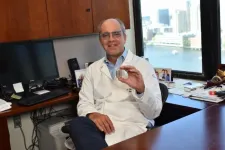(Press-News.org) Cloud ‘engineering’ could be more effective for climate cooling than previously thought, because of the increased cloud cover produced, new research shows.
In a study published in Nature Geoscience (https://www.nature.com/articles/s41561-024-01427-z), researchers at the University of Birmingham found that marine cloud brightening (MCB), also known as marine cloud engineering, works primarily by increasing the amount of cloud cover, accounting for 60-90% of the cooling effect.
Previous models used to estimate the cooling effects of MCB have focused on the ability of aerosol injection to produce a brightening effect on the cloud, which in turn increases the amount of sunlight reflected back into space.
The practice of MCB has attracted much attention in recent years as a way of offsetting the global warming effects caused by humans and buying some time while the global economy decarbonises. It works by spraying tiny particles, or aerosols, into the atmosphere where they mix with clouds and with the primary aim of increasing the amount of sunlight that clouds can reflect.
Experiments with the technique are already being used in Australia in an attempt to reduce bleaching on the Great Barrier Reef. However the ways in which MCB creates a cooling effect, and the ways in which clouds will respond to aerosols, are still poorly understood, because of variable effects such as the confounding from co-varying meteorological conditions.
To investigate the phenomenon, the researchers created a ‘natural experiment’, using aerosol injection from the effusive eruption of Kilauea volcano in Hawaii to study the interactions between these natural aerosols, clouds, and climate.
Using machine learning and historic satellite and meteorological data, the team created a predictor to show that how the cloud would behave during periods when the volcano was inactive. This predictor enabled them to identify clearly the impacts on the clouds that had been directly caused by the volcanic aerosols.
They were able to show that the cloud cover relatively increased by up to 50% during the periods of volcanic activity, producing a cooling effect of up to -10 W m-2 regionally. Global heating and cooling is measured in watts per square metre, with a negative figure indicating cooling. Note that doubling CO2 would lead to a warming effect of +3.7 W m-2 approximately on a global average.
The research was carried out in collaboration with the Met Office, the Universities of Edinburgh, Reading and Leeds, ETH Zurich in Switzerland, and the University of Maryland and NASA in USA.
Lead author, Dr Ying Chen, of the University of Birmingham, said: “Our findings show that marine cloud brightening could be more effective as a climate intervention than climate models have suggested previously. Of course, while it could be useful, MCB does not address the underlying causes of global warming from greenhouse gases produced by human activity. It should therefore be regarded as a ‘painkiller’, rather than a solution, and we must continue to improve fundamental understanding of aerosol’s impacts on clouds, further research on global impacts and risks of MCB, and search for ways to decarbonise human activities.”
The research comes alongside increased interest in cloud engineering around the globe. UK Research and Innovation has recently launched a £10.5m research programme looking at informing policymakers on solar radiation management approaches, including MCB, while the Advanced Research and Invention Agency (ARIA), is focused on researching technologies for climate and weather management. In the USA, a team from the University of Washington recently carried out its first outdoor aerosol experiment from a decommissioned aircraft carrier in Alameda, California.
Cloud ‘engineering’ could be more effective for climate cooling than previously thought, because of the increased cloud cover produced, new research shows.
In a study published in Nature Geoscience (https://www.nature.com/articles/s41561-024-01427-z), researchers at the University of Birmingham found that marine cloud brightening (MCB), also known as marine cloud engineering, works primarily by increasing the amount of cloud cover, accounting for 60-90% of the cooling effect.
Previous models used to estimate the cooling effects of MCB have focused on the ability of aerosol injection to produce a brightening effect on the cloud, which in turn increases the amount of sunlight reflected back into space.
The practice of MCB has attracted much attention in recent years as a way of offsetting the global warming effects caused by humans and buying some time while the global economy decarbonises. It works by spraying tiny particles, or aerosols, into the atmosphere where they mix with clouds and with the primary aim of increasing the amount of sunlight that clouds can reflect.
Experiments with the technique are already being used in Australia in an attempt to reduce bleaching on the Great Barrier Reef. However the ways in which MCB creates a cooling effect, and the ways in which clouds will respond to aerosols, are still poorly understood, because of variable effects such as the confounding from co-varying meteorological conditions.
To investigate the phenomenon, the researchers created a ‘natural experiment’, using aerosol injection from the effusive eruption of Kilauea volcano in Hawaii to study the interactions between these natural aerosols, clouds, and climate.
Using machine learning and historic satellite and meteorological data, the team created a predictor to show that how the cloud would behave during periods when the volcano was inactive. This predictor enabled them to identify clearly the impacts on the clouds that had been directly caused by the volcanic aerosols.
They were able to show that the cloud cover relatively increased by up to 50% during the periods of volcanic activity, producing a cooling effect of up to -10 W m-2 regionally. Global heating and cooling is measured in watts per square metre, with a negative figure indicating cooling. Note that doubling CO2 would lead to a warming effect of +3.7 W m-2 approximately on a global average.
The research was carried out in collaboration with the Met Office, the Universities of Edinburgh, Reading and Leeds, ETH Zurich in Switzerland, and the University of Maryland and NASA in USA.
Lead author, Dr Ying Chen, of the University of Birmingham, said: “Our findings show that marine cloud brightening could be more effective as a climate intervention than climate models have suggested previously. Of course, while it could be useful, MCB does not address the underlying causes of global warming from greenhouse gases produced by human activity. It should therefore be regarded as a ‘painkiller’, rather than a solution, and we must continue to improve fundamental understanding of aerosol’s impacts on clouds, further research on global impacts and risks of MCB, and search for ways to decarbonise human activities.”
The research comes alongside increased interest in cloud engineering around the globe. UK Research and Innovation has recently launched a £10.5m research programme looking at informing policymakers on solar radiation management approaches, including MCB, while the Advanced Research and Invention Agency (ARIA), is focused on researching technologies for climate and weather management. In the USA, a team from the University of Washington recently carried out its first outdoor aerosol experiment from a decommissioned aircraft carrier in Alameda, California.
END
Cloud engineering could be more effective ‘painkiller’ for global warming than previously thought - study
2024-04-11
ELSE PRESS RELEASES FROM THIS DATE:
AI model has potential to detect risk of childbirth-related post-traumatic stress disorder
2024-04-11
Media Availability
WHAT:
Researchers have adapted an artificial intelligence (AI) program to identify signs of childbirth-related post-traumatic stress disorder (CB-PTSD) by evaluating short narrative statements of patients who have given birth. The program successfully identified a large proportion of participants likely to have the disorder, and with further refinements—such as details from medical records and birth experience data from diverse populations—the model could potentially identify ...
Cardiovascular care centered on the patient is key and helps improve equity and outcomes
2024-04-11
Statement Highlights:
Patient-centered care establishes a respectful partnership among the health care team, the patient and caregivers to make shared decisions about management tailored to the patients’ beliefs, preferences and values.
Person-centered care can boost health equity and improve patients’ experiences and medical outcomes.
Fully incorporating patient-centered care will require involvement by patients, caregivers, health care professionals, medical schools and the health care system.
Embargoed until 4 a.m. CT / 5 a.m. ET Thursday, April 11, 2024
DALLAS, April 11, 2024 — Adult cardiovascular care centered on the patient can improve ...
Study confirms how RNA chemical modifications benefit HIV-1
2024-04-11
COLUMBUS, Ohio – A chemical modification in the HIV-1 RNA genome whose function has been a matter of scientific debate is now confirmed to be key to the virus’s ability to survive and thrive after infecting host cells, a new study has found.
This change to HIV-1 RNA, a tiny chemical modification on the adenosine building block of RNA known as m6A, is a common RNA editing process in all life forms that involves altering gene expression and protein production. The functional effect often represents a cellular solution but, in some cases, leads to disease.
By developing technological advances to observe a full length ...
Mass General study identifies an AI model that can accurately assess PTSD in postpartum women
2024-04-11
Key Takeaways:
An artificial intelligence model combined with a trained machine learning algorithm was found by Mass General researchers and collaborators to accurately identify childbirth-related post-traumatic stress disorder (CB-PTSD).
The findings could set the stage for a highly effective, low-cost, and readily accessible way to screen for the disorder, which affects up to 8M women worldwide.
Interventions could then be offered to the mother to reduce the trauma associated with the birthing process.
BOSTON – A generative artificial intelligence (AI) model that can ...
Studying alcohol production in the intestines of overweight patients
2024-04-11
The microorganisms in the intestines of many overweight people produce alcohol to an increased extent, as Max Nieuwdorp, professor of Internal Medicine at Amsterdam UMC discovered a few years ago. Breaking down that excessive alcohol leads to fatty liver, which in turn increases the risk of serious diseases such as diabetes and cardiovascular disease. Nieuwdorp has now received an ERC Advanced grant of 2.5 million euros for a major study into the underlying causes of excessive alcohol production. Ultimately, he hopes to find a way to prevent excess alcohol produced in the intestines, and thus the related diseases.
In 2022, Nieuwdorp ...
Robotically assisted lung transplants are on the horizon
2024-04-11
Embargoed until 8:30 am Thursday, 11 April, 2024 Central European Summer Time (GMT +2)
11 April, 2024, Prague, Czech Republic—While debating the pros and cons of robotically assisted lung transplantation, Albert Jauregui, MD, PhD told attendees at the Annual Meeting and Scientific Sessions of the International Society for Heart and Lung Transplantation (ISHLT), today in Prague that the time for robotic surgery is now.
Although robots are commonly used to assist in surgery, robotically assisted surgery is not routinely used for lung transplants. Approximately 4,600 ...
Breakthrough promises secure quantum computing at home
2024-04-11
The full power of next-generation quantum computing could soon be harnessed by millions of individuals and companies, thanks to a breakthrough by scientists at Oxford University Physics guaranteeing security and privacy. This advance promises to unlock the transformative potential of cloud-based quantum computing and is detailed in a new study published in the influential U.S. scientific journal Physical Review Letters.
Quantum computing is developing rapidly, paving the way for new applications which could transform services in many ...
Discovery brings all-solid-state sodium batteries closer to practical use
2024-04-11
The pursuit of greener energy also requires efficient rechargeable batteries to store that energy. While lithium-ion batteries are currently the most widely used, all-solid-state sodium batteries are attracting attention as sodium is far more plentiful than lithium. This should make sodium batteries less expensive, and solid-state batteries are thought to be safer, but processing issues mean mass production has been difficult.
Osaka Metropolitan University Associate Professor Atsushi Sakuda and Professor Akitoshi Hayashi, both of the Graduate School of Engineering, led a research team in developing ...
Case study of 4-year-old with down syndrome and sleep apnea suggests hypoglossal nerve stimulation can be effective treatment at young ages
2024-04-11
While Obstructive Sleep Apnea (OSA) affects about five percent of the general pediatric population, 80 percent of children with Down syndrome experience OSA. Continual OSA results in poor health, including disruptions to cognitive development and functioning, leading physician-researchers from Mass General Brigham to investigate better methods to treat these patients as early as possible to maximize their health outcomes.
In a new case study published April 11 in Pediatrics, they report on a 4-year-old boy with Down syndrome and OSA who underwent a procedure to implant a hypoglossal nerve stimulation device, and experienced improvements thereafter. ...
Transmission risk of multidrug-resistant bacteria appears highest in hospital sinks
2024-04-11
Arlington, Va. — April 11, 2024 — A new study published today in the American Journal of Infection Control (AJIC) reports the infection prevention steps taken to control a months-long multispecies outbreak of carbapenemase-producing Enterobacterales that occurred in a pediatric ward at the Toho University Omori Medical Center in Tokyo in 2017. This study highlights the particular vulnerability for contamination through sinks and other water sources; indeed, even replacing all sinks in the ward did not stop this outbreak.
Carbapenemase-producing Enterobacterales (CPE) are a major public health threat ...


